From Bulgari to Porsche: Branded Residences Are Flooding the Prime Market—and Selling
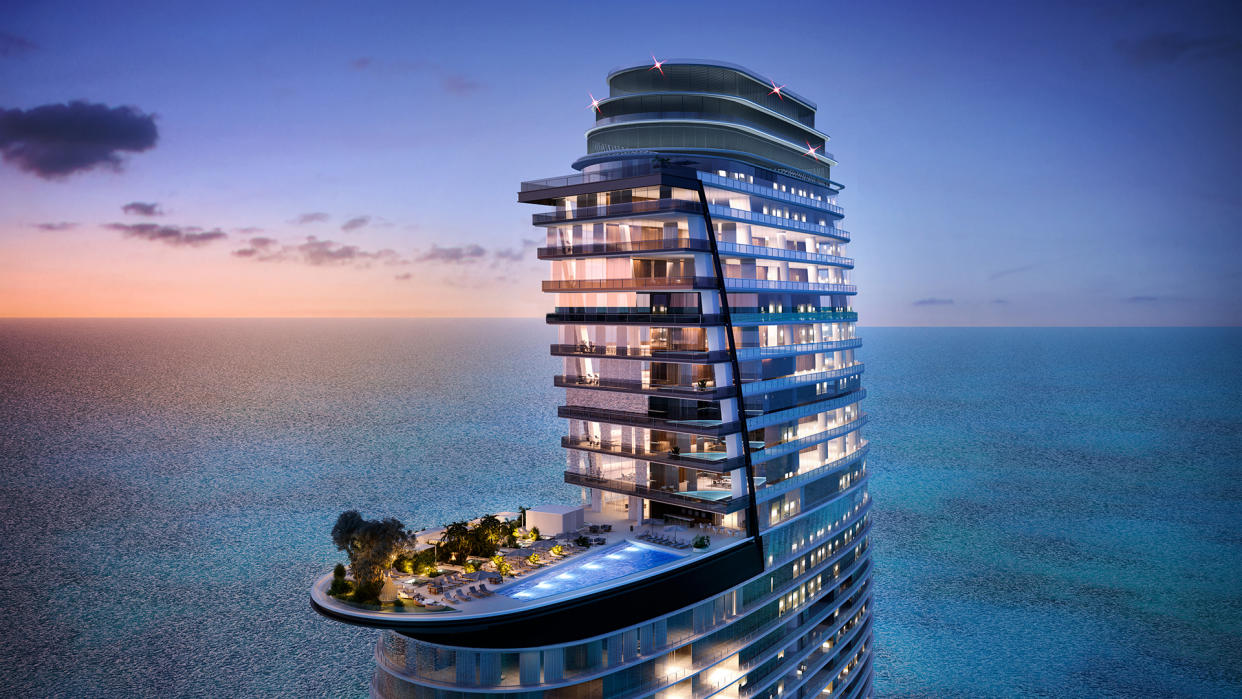
When the Sherry-Netherland apartment hotel debuted on New York’s Fifth Avenue in 1927, it had the distinction of being the world’s first “branded” residence, in this case leveraging the reputation of Sherry’s, a popular restaurant that had operated about 15 blocks south until the early days of Prohibition. With a Gothic minaret, a vaulted lobby that nodded to the Vatican library, and each of the top 14 floors a single, elegant apartment, the property quickly made an impact in the realm of posh real estate.
Nearly a century later, the category is surging—up some 150 percent over the past decade, according to London-based commercial-real-estate brokerage Savills. Today, real-estate design firm and consultancy WATG Strategy says there are over 700 branded residential developments, with upwards of 100,000 total homes either completed or in the planning stages, around the globe. And Savills predicts that the sector will double in size by 2027, fueled by a surge of prospective buyers in both established locations—New York, Miami, London, Dubai—and emerging markets as varied as Oman, Poland, and Guyana.
More from Robb Report
Car of the Week: This Ultra-Rare 1971 Porsche 914/6 Is Expected to Fetch up to $550,000 at Auction
A. Lange & Söhne Is Sponsoring the Audrain Newport Concours d'Elegance
What has changed in recent years—other than the sheer number of entrants into this increasingly lucrative sector, particularly at the luxury end of the spectrum—is the breadth of brands that want in on the action. The hotel companies that pioneered the concept are now joined by fashion and jewelry houses including Armani, Roberto Cavalli, Fendi, and Bulgari, as well as car marques such as Porsche, Bentley, and Aston Martin. Chris Graham, founder of Graham Associates, a leading consultancy in the field, calls a home with any of these designer labels a “trophy purchase.” He tells Robb Report, “People are quite keen on living there. It’s quite a badge of status.”
For the consumer companies and the real-estate developers alike, such partnerships are win-win. Brand names with cachet can translate to premiums on high-end real-estate developments, even in the most competitive markets.
Though variables such as location and a hotel component (or not) play a part, analysts suggest that when executed effectively—which means doing quite a bit more than merely slapping a familiar logo on sales materials—the right moniker can add upwards of 30 percent to a project’s sales price.
“The exact figure is always difficult to quantify and depends on a wide array of factors, but the premiums [that] brands add are very, very real,” says Edgardo Defortuna, president, CEO, and founder of Miami-based Fortune International Group, which has developed residences with Ritz-Carlton, St. Regis, and Auberge. “But, just as importantly, partnering with the right brand can vastly improve the speed and certainty of sales.”
Historically, hotel companies have been most likely to develop branded properties, with hospitality firms comprising some 84 percent of the sector, according to Savills. Which makes sense: Hoteliers already possess the know-how to both develop and operate properties—and what are residences, really, other than long-stay versions of short-stay hotel rooms?
“This is one of the reasons hotels have done so well,” says Liam Bailey, global head of research at Knight Frank in London. “They can point to a clear track record of delivering complex real-estate projects that successfully level their heritage and expertise.”
That organic evolution has hospitality brands continuing to flock to real estate. Peninsula, for instance, just entered the arena with the recently opened Peninsula Residences London, where a penthouse reportedly sold for about $123 million to U.S. hedge-fund mogul Ken Griffin. Aman, meanwhile, still a relatively modest-sized hospitality brand, reported $2.4 billion in sales of its branded residences in 2022 alone. Rob Sykes, associate vice president and director of strategy at WATG, says that Six Senses, Equinox, and Faena—the last of which recently became part of Accor’s expansive portfolio—are additional hotel names to watch for growth in the category.
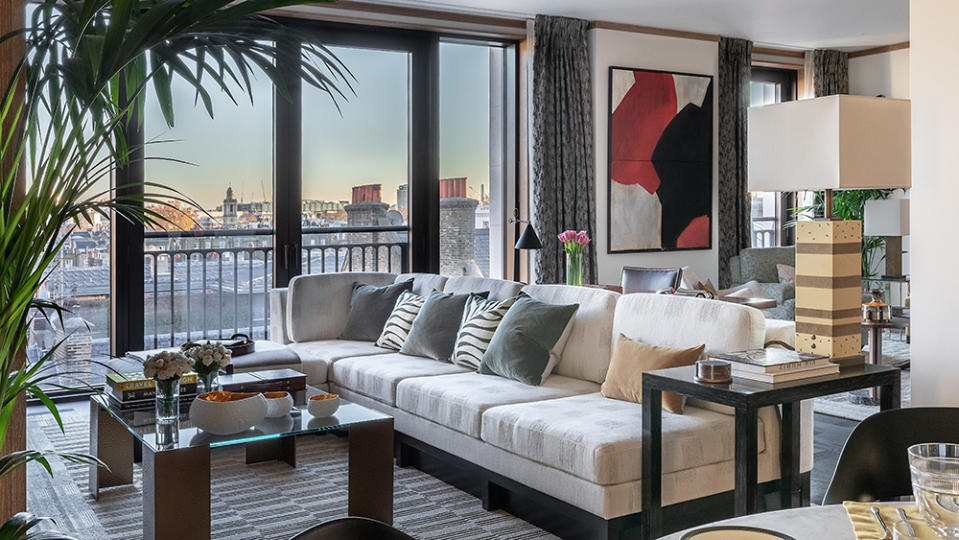
Six Senses CEO Neil Jacobs describes such projects as contributing to both financial and marketing goals, noting that approximately 50 percent of the chain’s new properties include residences. “Given the high costs of land today, having a residential component alongside the hotel helps justify the commercial viability of an entire development,” he says. “The branded-residence business was an immediate goal from the moment we bought the business in 2012. They are, in a sense, the most cohesive way to reflect the sense of community that we are trying to achieve as a company.”
Then there’s Mandarin Oriental, which has also made notable moves, launching its first residence-only properties in Barcelona, Beverly Hills and New York City, with a hybrid hotel-residence scheme coming to Tel Aviv. Marriott’s Edition is embracing the same approach, with the announcement, last year, of residence-only developments in Fort Lauderdale and Miami. Josh Fluhr, Edition’s senior vice president and global managing director, says such developments are the “ultimate proof point” of a hotel brand’s ability to succeed in the prime-property marketplace. South Florida, he notes, was the logical location for Edition’s first condo-only projects, thanks to its critical mass of deep- pocketed international buyers. But Sykes cautions that the shift to hotel-branded residences without actual hotels can be risky—and costly: Five-star services and amenities must be provided solely for residents, which can translate into higher maintenance fees.
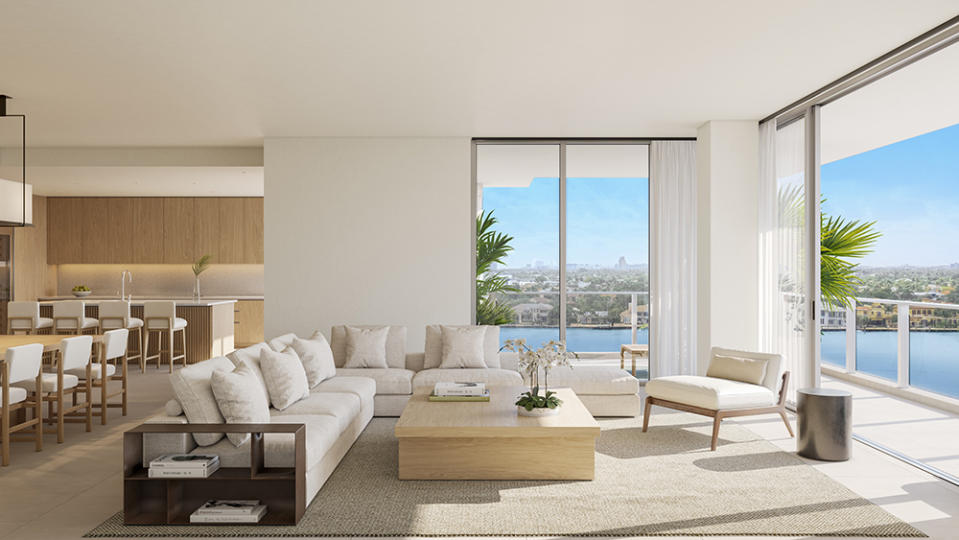
The marketplace can be more challenging for newcomers from non-hospitality fields whose core businesses might not, at first glance, translate into obvious residential iterations. There’s blingy Jacob the Jeweler, for instance, who has partnered with UAE-based developer Binghatti to erect what they plan will be the world’s tallest tower in—where else?—Dubai. Or take Nobu and Casa Tua, posh sushi and Italian chains, respectively, which are converting their exclusive dining expertise into full-throttle lifestyle brands.
Graham, the consultant, says his initial reaction to Nobu’s venture, in Los Cabos, Mexico, was, “Why the hell would anyone want to live in a restaurant-led environment?” But he admits he has been proven wrong. “It’s been phenomenal. They got it absolutely right. They sold out 300 apartments in six months—they went like hotcakes.” Nobu, which, it should be noted, branched into hotels before diving into condos, has new real-estate projects underway in Toronto and Dubai.

With outposts around the globe, these brands have demonstrated a built-in customer base. But any name that comes from outside the traditional hotel arena “does demand additional layers of due diligence,” Knight Frank’s Bailey explains. “The key question buyers must ask,” he adds, “is, ‘Who is ultimately responsible for delivering the final real-estate product and services?’”
By any measure, Dubai has emerged as the global hub of branded residences. There are 42 such projects now in development in the desert emirate, in addition to the 71 already in place, all built since the Armani Hotel opened its doors in 2010 inside the soaring Burj Khalifa. Occupying the top floors were 144 Armani apartments, the very first branded homes in the city. Armani has since expanded to such far-flung locales as London, Beijing, Istanbul, Mumbai, Manila, and Tel Aviv. In Miami, the iconic Italian fashion house teamed with architect Cesar Pelli on a 56-story sail-inspired high-rise that opened in 2020, with furnishings and fixtures from Armani/Casa, its design studio. The house’s next undertaking: 19 apartments in a 97,000-square-foot tower above the Armani flagship on Madison Avenue in New York.
In Dubai, a city fueled by consumption, the highest-end brands appear to be winning. Names such as Four Seasons, Bulgari, Lamborghini, and Ritz-Carlton, which just launched its fourth venture, lead the Dubai market, where branded schemes fetch a 37 percent premium over their non-branded counterparts, according to a January report from Morgan’s International Realty. Prices per square foot rose 14 percent during the second half of 2022, the report continued, with the Bulgari Resort and Residences at the top of the market, attaining prices three times the sector average.
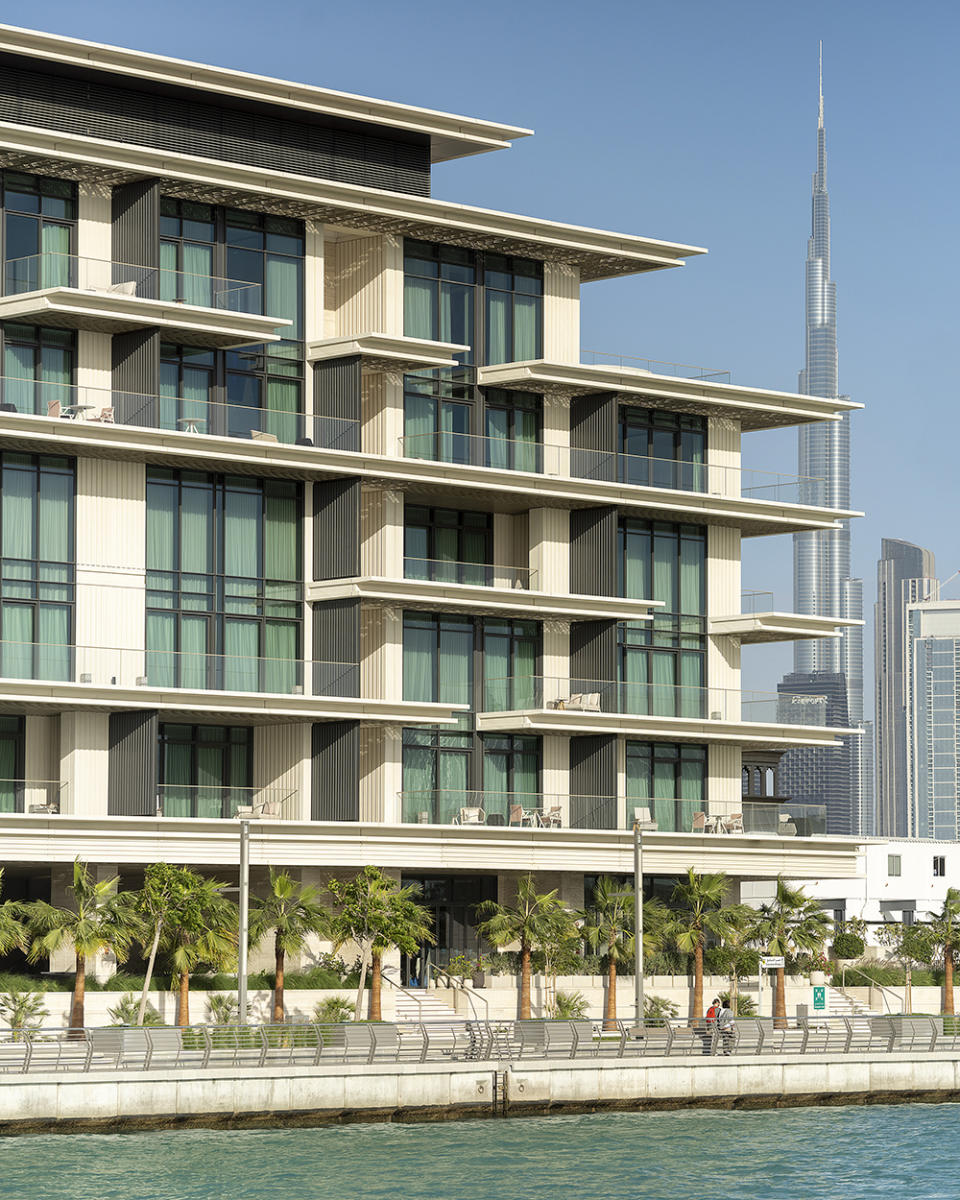
Before venturing into condos, the Roman jeweler built a reputation in hospitality, opening its first of many hotels in 2004, in Milan. “Bulgari-branded residences have been part of our strategy since the very beginning,” says Silvio Ursini, Bulgari group executive vice president. “The first sold were two penthouses in London in 2011.”
In the years since, the jewelry house has built an impressive portfolio that includes two luxury developments in Jumeirah Bay, one of Dubai’s prime neighborhoods. The first, Bulgari Resort and Residences, opened its doors in 2017; in addition to a splashy 101-room hotel, the property has 173 sea-facing apartments spread across six residential buildings, plus 15 private mansions. Last year, a three-bedroom unit reportedly closed for $10.9 million, or a record $3,450 per square foot. Ursini believes that consumers are willing to pay a premium when they’re attracted to the standards set by the company. “In our case, they are looking for a Bulgari-branded product, which means the Italian design and furniture and the impeccable services delivered by the Bulgari Hotel,” he says.
Also in the pipeline is the Bulgari Lighthouse, a striking 27-story tower designed by architectural firm Antonio Citterio Patricia Viel, scheduled for completion in 2027. The project, located next to the resort’s yacht club, has already set a new mark for Dubai: A 38,970-square-foot penthouse reportedly sold for about $112 million in an off-plan deal earlier this year. The development will include 31 penthouses and a three-level Sky Villa. Going forward, a majority of the jeweler’s projects will include residences, Ursini says, noting, “they are very important because they add a sense of community.”

Dubai typifies the fundamentals now fueling the branded trend worldwide: It’s a booming tourism hub with a robust hotel sector, and it boasts sunny days when Europe and North America are snowed under. There’s also a highly international population with substantial liquid capital. When you’re an expat, familiar names can provide a level of trust and security, whether you’re shelling out for a pair of shoes or your living quarters.
“Branded residences offer buyers a sort of guarantee,” says Niall McLoughlin, senior vice president of marketing and corporate communications at Dubai property giant Damac, which has developed luxury residential projects with Versace and Fendi and has another underway with Mandarin Oriental, slated for completion in 2025. “They also offer developers an added layer of confidence owing to their established track record when it comes to being meticulous about quality and details.”
Meanwhile, in Miami—which, like Dubai, is a highly international city and, not coincidentally, ranked by Savills as the world’s second-most-buoyant locale for branded developments—the boom is equally eclectic, with names from nearly every realm of the luxury arena aggressively breaking ground. Of particular note are the clutch tied to high-end automobiles, including Bentley Residences, Aston Martin Residences, and the established Porsche Design Tower, famed for its futuristic “Dezervator’’ elevator, an invention of Dezer Development’s Gil Dezer that delivers residents—and their cars—directly next to their homes.
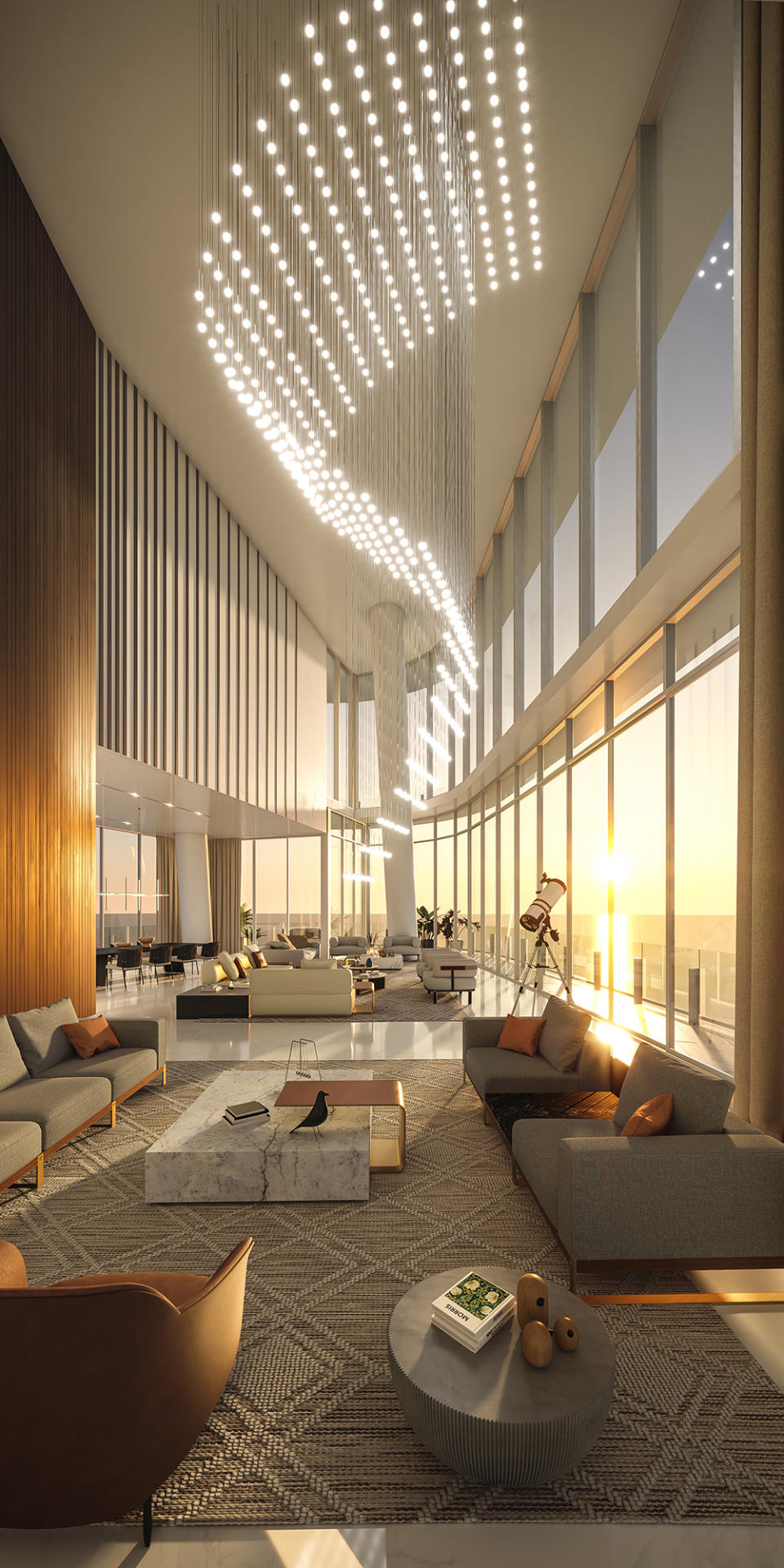
Porsche and Aston Martin, like the fashion houses, are playing to their super fans. At the latter’s 66-story waterfront high-rise under construction on Biscayne Boulevard downtown, only a few of the 391 units remain—one of which is a $59 million triplex penthouse that comes with a limited-edition Aston Martin Vulcan race car valued at $3.2 million. The 20,000-square-foot spread also includes a temperature-controlled garage located at the base of the building to store the vehicle. As a sweetener for other deals, buyers are being offered their choice of a DBX Riverwalk Edition or a DB11 V8 Coupe with the purchase of any of seven available penthouses or 38 “signature” condos.
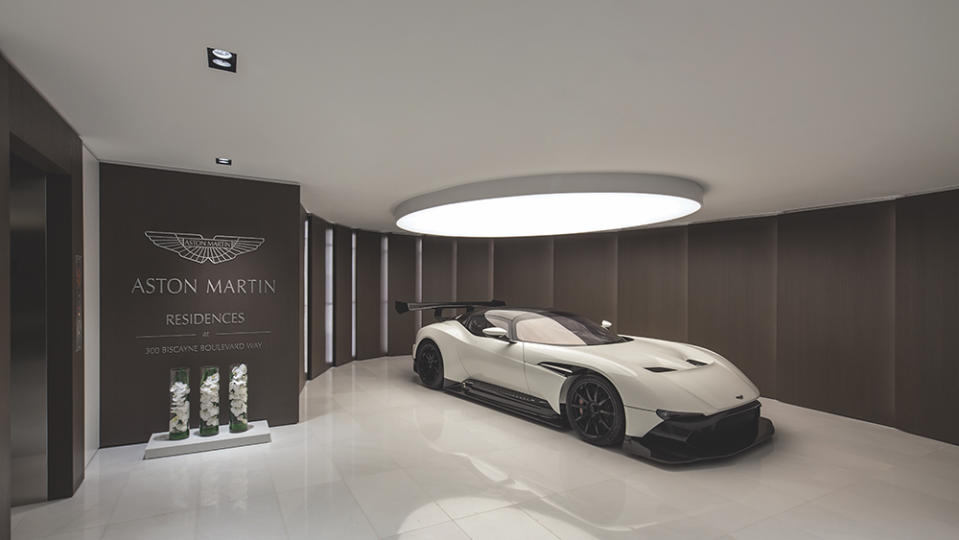
The sailboat-shaped condominium, on track to be the tallest residential building south of New York and slated for completion this year, inaugurates the British automotive manufacturer’s foray into residential development. Cathal Loughnane, director of Aston Martin Partnerships, says the tower will carry the same aesthetic DNA and high level of craftsmanship that the marque’s fans expect of its performance cars. “This project is far more than just the use of the Aston Martin name,” he insists, adding that the company is designing the common areas and amenity spaces, from the fitness center and spa down to the reception desks in the two lobbies. “We design sports cars for those who appreciate automotive art. Working with creative teams outside of the automotive industry helps to broaden our designers’ vision.”
Loughnane notes that the design-centric nature of real estate makes for a natural fit. “It enables us to further enhance and grow the brand into new aspects of the luxury world that appeal to both our existing and future customers.”
Bentley is aiming for the latter with its first effort, which is set to open in 2026 and dovetails with the British marque’s strategy “to become an absolute reference in sustainable luxury,” according to Alain Favey, board member for sales and marketing. By 2030, he explains, “we’ll be selling 100 percent electric cars, so in that prospect, we need to reach a new kind of audience—people who might not be traditional Bentley owners and who are more progressive and interested in sustainability.
“At this moment, we have no electric cars to sell, but if we want to be able to sell one in the future, we need to move the brand closer to these target groups,” he continues. “These groups aren’t passionate about cars necessarily, but they are passionate about real estate, architecture, and design. So having projects in this area is showing that the brand is evolving, and it makes the brand more appealing to those who might be buying our cars in the future.”
Bentley designers have collaborated with the architects on details large and small, among them the gym, cinema, and Macallan bar. The company has teamed with Porsche partner Dezer Development and so will have its own Dezervator and room for up to four cars in each apartment.
“You can actually bring your car into your unit and see it from your kitchen or pool and enjoy the look of it,” Favey explains. “It’s a bit extravagant, but in a way that we think is very close to what the reality of life in Miami is like. The whole concept is quite in tune with what the brand stands for.”
Favey says Bentley Miami will definitely not be a one-off. “It would be completely wrong for us to do only one,” he insists. “We’ll try to have similar projects around the world—in Asia and Europe—but every time expressing a different facet of the brand.”
Beyond the automotive category, everyone from Baccarat to Fendi, Missoni, Cavalli, and even Major Food Group (MFG) is working on a branded project in Miami. Casa Tua, which began as a chic private restaurant in the city, is innovating with its launch of Ora by Casa Tua, which melds the concepts of a members club with residential real estate. With the name Ora (“now” in Italian), it’s also tapping into the emerging trend of developers inventing new brands specifically for real estate, giving the projects distinct identities and DNA.

Fortune International has also created its own top-tier brand, Jade, which has evolved into a full-fledged portfolio with four sites in Miami and nearby Sunny Isles, along with the tri-tower Jade Park now rising in Asunción, Paraguay. Fortune’s Defortuna says the brand, although new and relatively modest in scale, has been a strong draw for South American buyers, many of whom were already Jade residents in Florida. “At least 20 of our Paraguay buyers owned or had previously rented at Jades in Miami,” he says. Other developer-devised brands include Icon, also mostly located in Miami, as well as Yoo, which kickstarted the trend more than 15 years ago with residences designed by Philippe Starck.
The blending of hospitality, members clubs, and real estate is perhaps the next big shift, according to Bailey, of Knight Frank. Jacobs, the CEO of Six Senses, describes this triumvirate as the “residence-hotel-club” ecosystem that helps solidify a project’s overall sense of community.
In New York, the world’s third-largest branded-residences market, the new Aman perfectly exemplifies this trend, with ultra-luxury residences, a five-star hotel, and a private club all set within a stunningly restored Art Deco building. While this troika might not necessarily work for every operator—members clubs, for instance, typically find the most success in urban areas—they illustrate the increasing desire of top-end buyers to have every imaginable indulgence under one roof. The familiar brand name provides all sides with security and confidence, particularly in markets where wealth may still be new and the long-term returns of luxury real estate still untested.
As the sector continues to grow, perhaps the biggest downside for prospective buyers will be facing the same quandary that vexes them every morning in their closets (Armani or Versace?) and garages (Porsche or Bentley?). But with options popping up around the globe, maybe the answer is one of each.
With additional reporting by Mark Ellwood
Best of Robb Report
Sign up for Robb Report's Newsletter. For the latest news, follow us on Facebook, Twitter, and Instagram.

